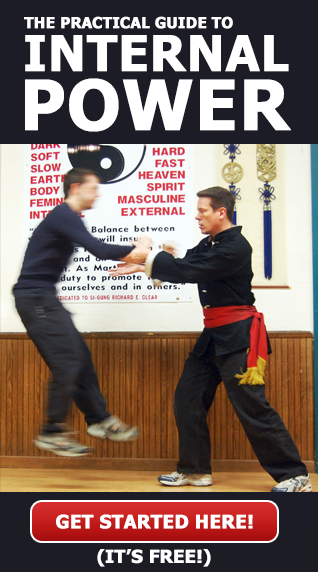Thank you to Michael Smith for the historical facts regarding the history of Tai Chi and the proximity of the Chen Village to the Shaolin temple.
I studied Kung Fu and Chi Kung for several years before I began my studies in Tai Chi. My primary Kung Fu instructors were also my first Tai Chi teachers. When I first began practicing Tai Chi I noticed that a lot of the moves shared characteristics with the Kung Fu I was studying. Obviously the primary difference between Kung Fu and Tai Chi was that in the beginning of training the Tai Chi was trained much softer and slower than the external Kung Fu.
I did some reading on Tai Chi history and became aware of Chan San Feng and the story that Tai Chi was first developed by a monk who saw a snake and a crane fighting. At times as I learned and worked on the Tai Chi I considered how the moves worked in that context. I found that much of the Shaolin snake and crane style movement and nuances were present in the Tai Chi. This includes cranes tendency to stand on one leg and move around the center point as well as snakes tendency to move subtly with an adjusting focus from the center that is not seen until the last instant due to the hidden nature of the movement.
I also found that some of the Tai Chi moves had Tiger in the name i.e. “Tiger Returns to Mountain” and that many of these moves (under different names) can be found in Tiger style Kung Fu. I was surprised at first as Tiger is the first and generally most external animal in Shaolin. However, there are some soft moves in Tiger style that are meant to defeat moves from another Tiger stylist and generally these are the ones that are most often found in Tai Chi.
However, there are some fairly aggressive moves from the animal styles that can be found in Tai Chi as well. For instance “Brush Knee” can be found in Snake and Tiger style Kung Fu.
In Snake style the brush knee hand is withdrawing and drawing in the attacker and the pushing hand is thrust forward slightly to the other side of the pivot point / center of gravity to a point of weakness so that the attacker goes flying with very little effort from the Snake practitioner. Also, the Snake strike can be to a pressure point which is activated by the other hand withdrawing and stretching the meridian from the point of contact. Picture grabbing and pulling someone right arm so that they are being stretched and turned and then touching them on a pressure point on the left side of their chest with your finger tip(s) with your whole body weight driving the strike.
As for Tiger picture the brush knee as a Tiger hand clearing the opponents arms out of the way and then the other hand does a Tiger hand palm strike into them. Once again the Tiger arm clearing technique is turning them to the side and then the striking / pushing hand is striking them in the center while they are in the process of turning. Once their balance is compromised the opponent essentially trips over their own legs and goes flying back because of their own body weight falling and trying to regain balance.
It is my personal belief that Tai Chi was originally developed by the old monks who were refined masters of external Kung Fu, Dim Mak pressure points both for healing and for fighting and Chi Kung energy work. They understood true refined economy of motion, the human body, momentum, energy etc. and realized that it was foolish for an older man to use external Kung Fu to compete / fight a 25 year old in the peak of health who had been studying the same external Kung Fu arts for 20+ years in the temple. So one or more of the old monks utilized the knowledge they had learned and personally gained through practice and experience of both the healing and martial arts and applied that science to create a training and fighting method that would be great for health and for fighting into advanced years. I also believe that this is why they named the art Tai Chi Chuan translated as Supreme Ultimate Boxing.
Much of the origins of Tai Chi is considered to be unknown and a mystery. I welcome comments and questions on this post and I hope to spark a stimulating conversation whereby we can all benefit from a greater understanding of the real Tai Chi history.

Speak Your Mind